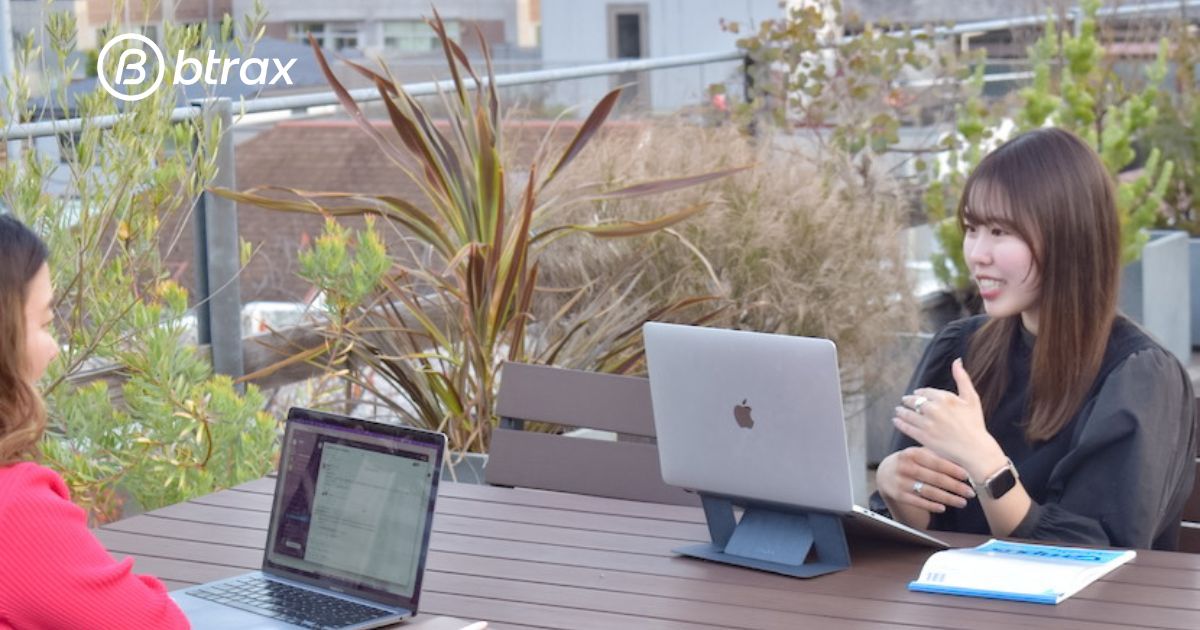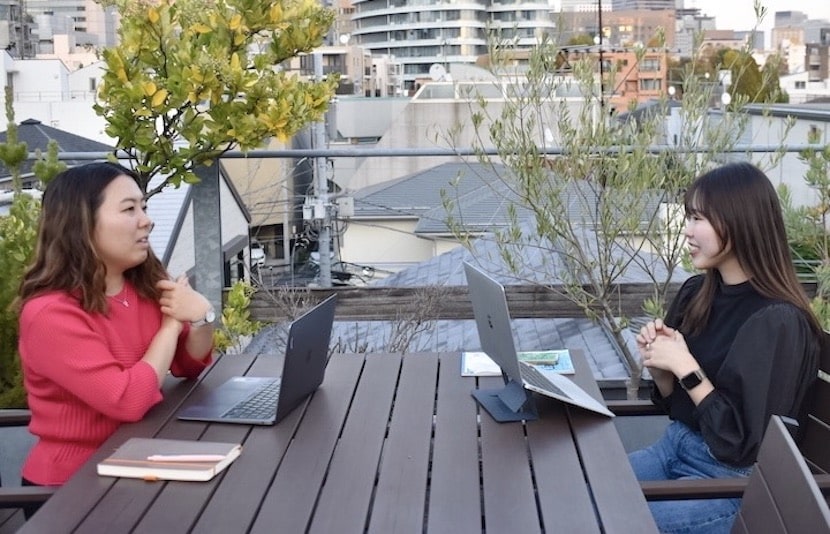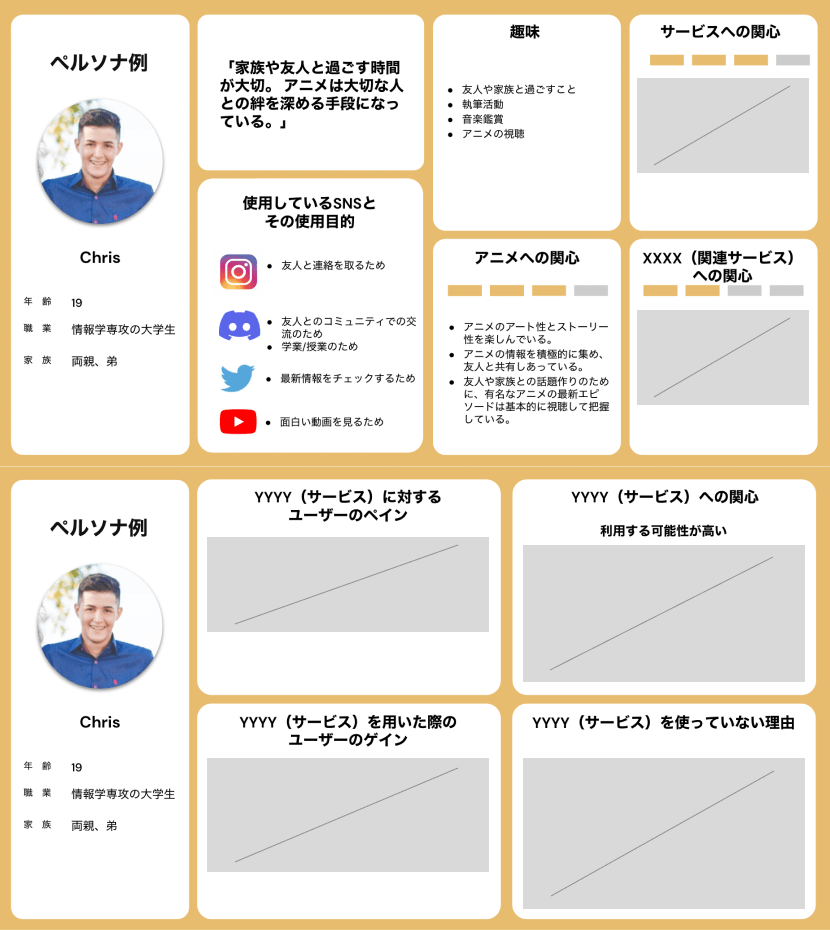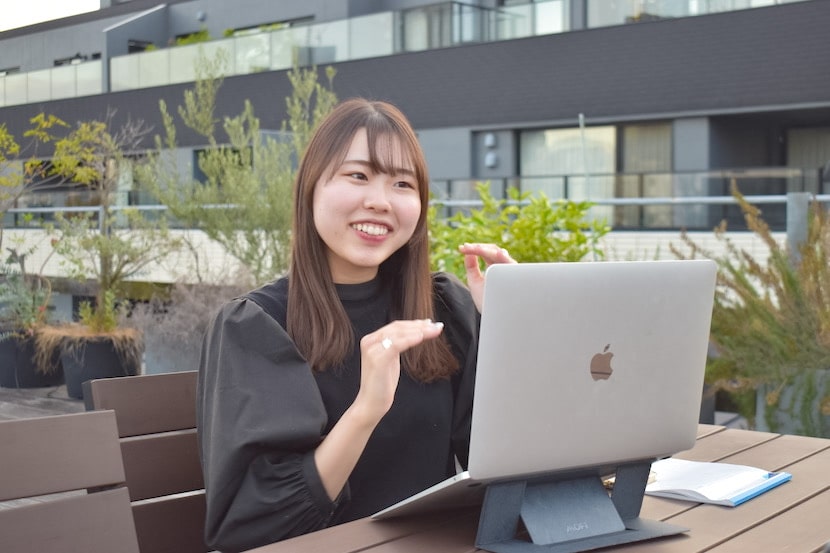
Btrax Design Company > Freshtrax > The Importance ...
The Importance of “Fan Building” for Companies: Case Studies, User Research (Part 1)
At btrax, we conduct user interviews to visualize needs and guide service optimization by interviewing users in our North American target audience.
In this article, we will focus on a case study of user interviews and marketing strategies in North America, and introduce the benefits of research in different cultural backgrounds from the perspective of a business producer and a marketer who were involved in the project.

What is the value of conducting user interviews that market research alone cannot reveal?
Mana (Business Producer):.
This year, btrax conducted user research in the U.S. for a Japanese entertainment company. Can you tell us about that project in as much detail as you can? If possible, could you also tell us about the goals of the project?
Ayaka (Marketer):
Well, the goal of this project was to attract new users in North America.
To achieve that goal, btrax proposed a plan to assess the current user base in North America and the strengths of its services, as well as a foothold for future marketing initiatives to acquire more users in North America.
To provide some context, the service that this company was developing for the global market was exploding in North America, but the company had little insight into why it was so popular among North American users or what kind of people were using the service in North America.
So, we conducted user interviews with North American users, developed personas based on the interviews, and proposed several marketing initiatives for each of the personas.
Rather than lumping “North American users” into a single category, we divided the users into groups according to the goals of this study and conducted the interviews while optimizing the questions for each user group.
During the interviews, we asked about the role of the service in each user’s daily life and what the service meant to the user. This allowed us to clarify the profile of each user based on his or her impression of the service.
Mana:
So you established personas from those interviews. How did you develop the personas from the characteristics you saw during the interviews?
Ayaka:
Certainly. In the course of our user research, we were looking into what kind of approach we should take in creating user personas, and in the course of our team discussions, we discovered that there is a correlation between the reasons why people want to use the service and their actual motivation to use the service.
Although it may sound vague, we found that people who want to use the service for purpose A are not very motivated to use it, but people who want to use the service for purpose B are very motivated to use it.
Based on this correlation, personas were created based on the purpose for which each user wanted to use the service.
For each persona, we tried to include as many details and insights as possible that would be important for targeting in the future.
In particular, we asked the users where they learned about the service – through social media or word of mouth, to gain insight into the best way to reach potential customers.
Furthermore, we kept in mind the following points of view: What triggers a user to try using the service once they have learned about it? What would make a user want to continue using the service once he or she has started using it?
What would allow the service to naturally integrate into the user’s daily life as much as possible? I always kept this perspective in mind.

During the interviews, what struck me was that almost all of the interviewees were unanimous in their opinions of the service. This was a major takeaway from the interviews, as it became clear to me that this was the reason for the service’s popularity and expansion in North America.
Making unexpected discoveries is another value of user interviews.
Ayaka:
Another more distinctive finding was the use of social media sites.
In the North American region, Discord (an online community tool) is mainly used for community participation and communication in online communities, while information is primarily collected through official accounts such as Twitter.
In fact, the team initially hypothesized that users in their teens and twenties might use TikTok to become aware of the service. However, TikTok did not come up at all. The fact that this kind of bias can be solved is one of the major values of conducting user interviews.
Once personas were created, we explored what kind of messaging would resonate with each persona and how we could better promote the strengths of our clients service to make it seem more appealing compared to competing services.
In particular, we mapped the service that was the subject of the survey to the competing services mentioned in the user interviews to identify which people belonging to which personas were attracted to which services. Based on these findings, we developed marketing initiatives.
Mana:
Thank you for your explanation. It’s so interesting that the users in your study have so many different tendencies compared to users in Japan.
Ayaka, I know you are particularly familiar with the Japanese market and its users, but this time you have decided to target US users. Did you have to make any special adjustments to achieve this?

Ayaka:
Right, I feel that it is much more difficult to come up with a strategy for users whose culture and way of thinking are different from my own.
One thing I tried to do for this project was to refer to the opinions of local residents as much as possible and to seek feedback on the strategies from people who are closer to the user’s own culture and way of thinking.
At btrax, our offices in Japan and the U.S. work together seamlessly, so I was able to consult with some American members of the team for advice on strategy and messaging for the U.S.. I was able to ask for feedback from design team members some of whom actually use similar services as the users.
We felt the advantage of this collaboration during the user interviews as well. Especially this time, since North American users were the target of the interviews, it was very helpful to be able to conduct the user interviews with staff from both the Japanese and U.S. offices.
Mana:
Oh, I see. So that is one of btrax’s unique strengths. Earlier, you mentioned that you noticed some unexpected findings, like the fact that not everyone is using TikTok.
The growing importance of “fan building” for companies
Ayaka:
This service actually had many anime fans as users, we realized how positive it can be for a business to have its users become “fans” of its products. There were two points in particular that I felt after listening to many different opinions through the user interviews.
The first is that fans are personally engaging in activities that expand public awareness, such as creating fan art based on their love of a character or because they were moved by an anime they saw.
Fan art is a bit of a gray area for Japanese anime, but content created by fans can often embody the consumer’s fantasies or “what they wish it were like,” and can be valuable content for other fans as well.
This should be viewed as a positive factor in increasing engagement with the company as well as in expanding brand awareness more widely.
Earlier I mentioned that fan art is a gray area in terms of copyright, but SPY x FAMILY seems to have succeeded in further expanding brand recognition and establishing a fan base by encouraging fan art.
They even distributed coloring books of the characters from the anime on Twitter for fans to color in and make their own, and they held official contests for fan art. (Reference)
Second, because we like a subject, we are tempted to invest in it.
It’s a very positive feeling, “because I like it” or “because I want to support it,” and it’s the kind of emotion that can relieve some of the inhibitions we feel when we invest in something.
For companies, creating “fans” could be an increasing advantage in the future, as seen in the business aspects and trends mentioned above.
I think that the way in which companies communicate with their fans will become increasingly important as we become more and more connected through the internet.
Conclusion
This time we have introduced an actual case study involving user interviews and marketing measure planning targeting users in the U.S..
Through user interviews with North American targets, btrax has been able to visualize needs and optimize services for companies that have offices in Japan and the U.S. and are looking to expand from Japan to the U.S. market.
Additionally, in order to realize the best way of communicating with these targets, the company provides marketing strategy planning and design services for clients, from planning to execution.
Interested in learning more about the services we offer? Please contact us.
The second installment of this report will focus on “fan building” in the Japanese and U.S. markets. Please be sure to watch for the second article in this series.








